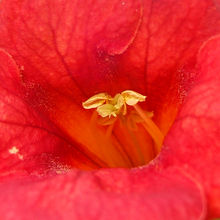Big climbing trumpet
| Big climbing trumpet | ||||||||||||
|---|---|---|---|---|---|---|---|---|---|---|---|---|

Great Trumpet Flower ( Campsis x tagliabuana ) |
||||||||||||
| Systematics | ||||||||||||
|
||||||||||||
| Scientific name | ||||||||||||
| Campsis × tagliabuana | ||||||||||||
| ( Vis. ) Rehder |
The great climbing trumpet or hybrid climbing trumpet ( Campsis × tagliabuana , syn .: Tecoma tagliabuana Vis.) Is the hybrid of the two types of trumpet flowers American climbing trumpet ( Campsis radicans ) and Chinese climbing trumpet ( Campsis grandiflora ).
description
The great climbing trumpet is a deciduous, shrubby liana . With the help of its adhesive roots , it reaches heights of 4 to 10 meters.
The opposite leaves are initially light green, later strong medium green. They are imparipinnate with 7 to 11 long, pointed leaflets that are sawn on the edge .
From June to September the trumpet-shaped, weakly zygomorphic flowers appear in clusters at the ends of the annual shoots. The predominantly orange to brick-red, hermaphrodite flowers consist of five fleshy sepals and five funnel-shaped petals that are fused together . They have two longer and two shorter, curved stamens . The upper ovary is surrounded by an abundant nectar producing disc .
The pollination is done depending on the location by hummingbirds, bees and bumblebees. There are fruit capsules formed containing numerous winged seeds.
Location and use
The great climbing trumpet prefers very warm, sunny to semi-sunny locations with evenly moist subsoil without waterlogging. It thrives on sandy as well as loamy soil with a pH of 6.1 to 7.8.
This hybrid can withstand temperatures as low as −17 ° C. This makes it more sensitive to frost than the American climbing trumpet and therefore may need winter protection.
As an ornamental plant , it is mainly used because of its decorative flowers for greening houses on west and south walls as well as on walls.
Botanical history
Campsis × tagliabuana is a cultivated hybrid that was probably first noticed around 1850 in the gardens of the Prince of Litta in Lainate . The first person to describe Roberto de Visiani honored with the epithet gardeners Alberto Linneo Tagliabue and Carlo Tagliabue, "two around the garden culture highly deserved brothers" of which he had received the plant.
Variety selection
- 'Coccinea'
- 'Takarazuka Gold'
- 'Indian Summer'
- 'Madame Galen'
swell
Individual evidence
- ↑ Visiani, R. (1859) Recensio altera plantarum minus cognitarum quas hortus patavinus colit . Atti dell'IR Istituto Veneto di Scienze, Lettere ed Arti , Ser. III, 4: 135.
Further literature
- Robert Zander : Zander. Concise dictionary of plant names. Edited by Walter Erhardt , Erich Götz, Nils Bödeker, Siegmund Seybold . 17th edition. Eugen Ulmer, Stuttgart 2002, ISBN 3-8001-3573-6 .
- Gordon Cheers (Ed.): Botanica: The ABC of Plants. 10,000 species in text and images . Tandem Verlag, 2003, ISBN 3-8331-1600-5 .
- G. López Gónzales: Los arboles y arbustos de la Península Ibérica e Islas Baleares , vol. 2. Mundi Prensa Libros SA, 2001, ISBN 84-7114-953-2 .
Web links
- Campsis × tagliabuana in the Germplasm Resources Information Network (GRIN), USDA , ARS , National Genetic Resources Program. National Germplasm Resources Laboratory, Beltsville, Maryland.
- Horticultural database of the University of Hohenheim

